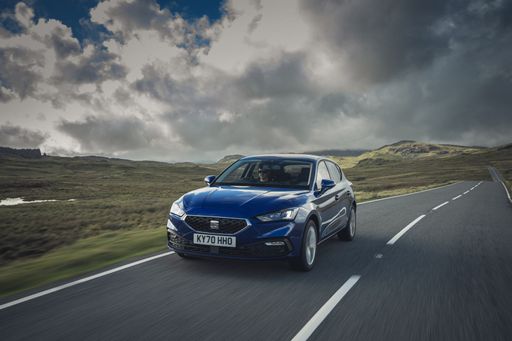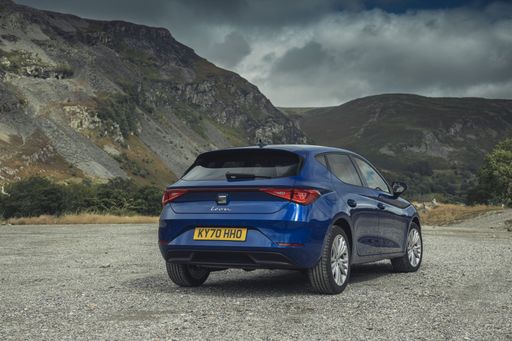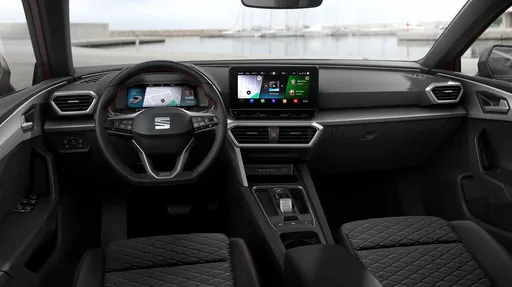SEAT Leon vs Renault R4 – Differences & prices compared
Compare performance, boot space, consumption and price in one view.
Find out now: which car is the better choice for you – SEAT Leon or Renault R4?
The SEAT Leon (Hatchback) comes with a Petrol, Petrol MHEV, Diesel or Plugin Hybrid engine and Manuel or Automatic transmission. In comparison, the Renault R4 (SUV) features a Electric engine with Automatic transmission.
When it comes to boot capacity, the SEAT Leon offers 380 L, while the Renault R4 provides 420 L – depending on how much space you need. If you’re looking for more power, decide whether the 272 HP of the SEAT Leon or the 150 HP of the Renault R4 suits your needs better.
In terms of consumption, the values are 0.30 L per 100 km for the SEAT Leon, and for the Renault R4.
Price-wise, the SEAT Leon starts at 24500 £, while the Renault R4 is available from 25200 £. Compare all the details and find out which model fits your lifestyle best!
SEAT Leon
The SEAT Leon impresses with its dynamic design and sporty edge, making it a standout choice in its class. Its interior is characterised by a modern, driver-focused cockpit that combines functionality with an emphasis on comfort. The car delivers a responsive driving experience, thanks to its advanced engineering and agile handling capabilities.
details @ seatmedia
@ seatmedia
 @ seatmedia
@ seatmedia
 @ seatmedia
@ seatmedia
 @ seatmedia
@ seatmedia
Renault R4
The Renault R4, affectionately known as the "R4," is a quintessential symbol of French automotive simplicity and practicality. This classic compact car, originally introduced in the early 1960s, won over numerous enthusiasts with its versatile design and dependable performance. Its no-frills charm and robust build made it a beloved choice for rural drivers and city dwellers alike, cementing its status as an iconic piece of automotive history.
details

|
|
|
|
|
Costs and Consumption |
|
|---|---|
|
Price
24500 - 36400 £
|
Price
25200 - 31200 £
|
|
Consumption L/100km
0.3 - 5.7 L
|
Consumption L/100km
-
|
|
Consumption kWh/100km
-
|
Consumption kWh/100km
-
|
|
Electric Range
133 - 134 km
|
Electric Range
322 - 409 km
|
|
Battery Capacity
19.70 kWh
|
Battery Capacity
40 - 52 kWh
|
|
co2
7 - 129 g/km
|
co2
0 g/km
|
|
Fuel tank capacity
40 - 45 L
|
Fuel tank capacity
-
|
Dimensions and Body |
|
|---|---|
|
Body Type
Hatchback
|
Body Type
SUV
|
|
Seats
5
|
Seats
5
|
|
Doors
5
|
Doors
5
|
|
Curb weight
1344 - 1670 kg
|
Curb weight
1485 - 1537 kg
|
|
Trunk capacity
270 - 380 L
|
Trunk capacity
420 L
|
|
Length
4368 mm
|
Length
4144 mm
|
|
Width
1799 mm
|
Width
1808 mm
|
|
Height
1442 - 1460 mm
|
Height
1552 mm
|
|
Payload
460 - 521 kg
|
Payload
410 - 443 kg
|
Engine and Performance |
|
|---|---|
|
Engine Type
Petrol, Petrol MHEV, Diesel, Plugin Hybrid
|
Engine Type
Electric
|
|
Transmission
Manuel, Automatic
|
Transmission
Automatic
|
|
Transmission Detail
Manual Gearbox, Dual-Clutch Automatic
|
Transmission Detail
-
|
|
Drive Type
Front-Wheel Drive
|
Drive Type
Front-Wheel Drive
|
|
Power HP
110 - 272 HP
|
Power HP
122 - 150 HP
|
|
Acceleration 0-100km/h
7.7 - 10.5 s
|
Acceleration 0-100km/h
8.2 - 9.2 s
|
|
Max Speed
197 - 220 km/h
|
Max Speed
150 km/h
|
|
Torque
220 - 360 Nm
|
Torque
225 - 245 Nm
|
|
Number of Cylinders
4
|
Number of Cylinders
-
|
|
Power kW
85 - 200 kW
|
Power kW
90 - 110 kW
|
|
Engine capacity
1498 - 1968 cm3
|
Engine capacity
-
|
General |
|
|---|---|
|
Model Year
2024 - 2025
|
Model Year
2025
|
|
CO2 Efficiency Class
D, B
|
CO2 Efficiency Class
A
|
|
Brand
SEAT
|
Brand
Renault
|
SEAT Leon
The SEAT Leon: A Blend of Performance and Innovation
The SEAT Leon has firmly established itself as a standout model, blending sleek aesthetics with cutting-edge technology. Known for its versatility and dynamic performance, this hatchback has become a staple choice for drivers seeking style and substance. Join us as we delve into the technical intricacies and innovative features that make the SEAT Leon a formidable contender in its class.
Dynamic Engine Options
The SEAT Leon offers a diverse range of engine choices, catering to various driving preferences. From efficient petrol options with mild-hybrid technology to powerful diesel engines, the Leon provides an impressive power range between 110 to 204 PS. Drivers can also opt for the environmentally friendly plug-in hybrid, featuring a 1.4 e-HYBRID powertrain that boasts a consumption rate as low as 1.1 L/100km and an electric range of up to 63 km.
Advanced Transmission Systems
Optimising driving efficiency, the SEAT Leon is available with both a manual gearbox and an advanced automatic dual-clutch transmission (DSG). The DSG offers seamless gear changes, enhancing the driving experience by providing precise control and improved fuel economy. This versatility allows the Leon to cater to drivers who appreciate the traditional feel of manual shifting and those who prefer the convenience of automatic transmissions.
Intelligent Design and Comfort
The SEAT Leon’s interior is designed with the modern driver in mind. Sporting a spacious cabin accommodating up to five passengers, it provides a balance of comfort and functionality. The boot space ranges from 270 to 380 litres, ensuring ample room for luggage. The Leon's ergonomic layout, coupled with optional advanced features such as ambient lighting and premium upholstery, positions it as a leader in comfort and practicality.
Cutting-edge Technology and Safety
The SEAT Leon is not just about performance; safety features prominently in its design. It is equipped with the latest driver assistance systems, such as adaptive cruise control and lane-keeping assist, ensuring a safer driving experience. The infotainment system offers seamless connectivity, supporting both Android Auto and Apple CarPlay, enabling drivers to stay connected while on the road.
Efficiency and Sustainable Driving
Emphasising sustainability, the SEAT Leon offers CO2 emissions ranging from 25 to 132 g/km, showcasing its commitment to environmental responsibility. Fuel consumption varies between a thrifty 1.1 to 5.8 L/100km, catering to both eco-conscious drivers and those focused on performance. With a competitive price range, the Leon stands out as an economical choice in its segment, balancing initial cost and long-term benefits.
Conclusion
The SEAT Leon continues to set benchmarks with its combination of style, performance, and technological innovation. Its array of engine options, advanced safety features, and luxurious interior make it a compelling choice for modern drivers. Whether you prioritise fuel efficiency, power, or comfort, the SEAT Leon offers a tailored driving experience unmatched in its class.
Renault R4
The Timeless Charm of the Renault R4: A Journey from Classic to Contemporary
The Renault R4 is an iconic name that echoes through automotive history, its roots deeply entrenched in the legacy of Renault's innovative engineering. As we usher into 2025, the classic appeal of the R4 meets modern innovation with the latest electric versions. Let's explore what makes the Renault R4 a remarkable blend of nostalgia and technology.
A Classic Reinvented: The Renault R4 Specifications
The Renault R4 is primarily an SUV, showcasing its versatility as both a practical family car and an adventurous road companion. The latest model comes with the robustness and aesthetic appeal we've come to expect from Renault, enhanced by cutting-edge electric powertrains.
Designed as an electric vehicle, the new Renault R4 variations come with different battery capacities ranging from 40 kWh to 52 kWh. These provide impressive ranges of up to 322 kilometers and 409 kilometers, catering to both urban and suburban travel needs. The power output ranges from a respectable 122 HP to a more robust 150 HP, ensuring a dynamic driving experience.
Performance Meets Innovation
The Renault R4 is equipped with front-wheel drive and automatic transmission, offering smooth and efficient performance. Speed enthusiasts will appreciate the acceleration from 0 to 100 km/h in just 8.2 to 9.2 seconds, while adhering to a maximum speed of 150 km/h. Torque figures range from 225 Nm to 245 Nm, ensuring responsive handling and robust performance on various terrains.
Weighing between 1485 kg and 1537 kg, the R4 balances weight and power adeptly. It boasts a trunk capacity of 420 liters, catering to family trips, weekend getaways, or simple grocery runs with ease. The modern design accommodates five passengers comfortably, with ample space and quality interiors.
Sustainable Future: The Eco-Friendly Appeal
Reducing carbon footprints is a significant feature of the new Renault R4, which stands proudly with a CO2 emission rate of 0 g/km, placing it in the A class for CO2 efficiency. This marks a step towards achieving environmentally-friendly transportation without compromising the significant power and performance expected from a traditional SUV.
Comfort and Utility: Perfect for Modern Lifestyles
Renault has crafted the R4 to suit the needs of the modern driver, focusing on comfort, utility, and sustainability. It measures 4144 mm in length, 1808 mm in width, and 1552 mm in height, perfect for navigating both city streets and open highways. The payload capacity ranges between 410 kg and 443 kg, demonstrating its capacity for carrying both people and cargo efficiently.
Conclusion: The Renault R4 Legacy Continues
The Renault R4 continues to be a symbol of innovation and practicality. Its evolution from past to present-day models features a brilliant synthesis of nostalgic allure and state-of-the-art technology. With its recent models, the R4 not only preserves its iconic status but also sets new standards for electric SUVs in the modern market. As we look forward, the Renault R4 remains a cherished companion on the roads, echoing the spirit of exploration and sustainability.
The prices and data displayed are estimates based on German list prices and may vary by country. This information is not legally binding.
